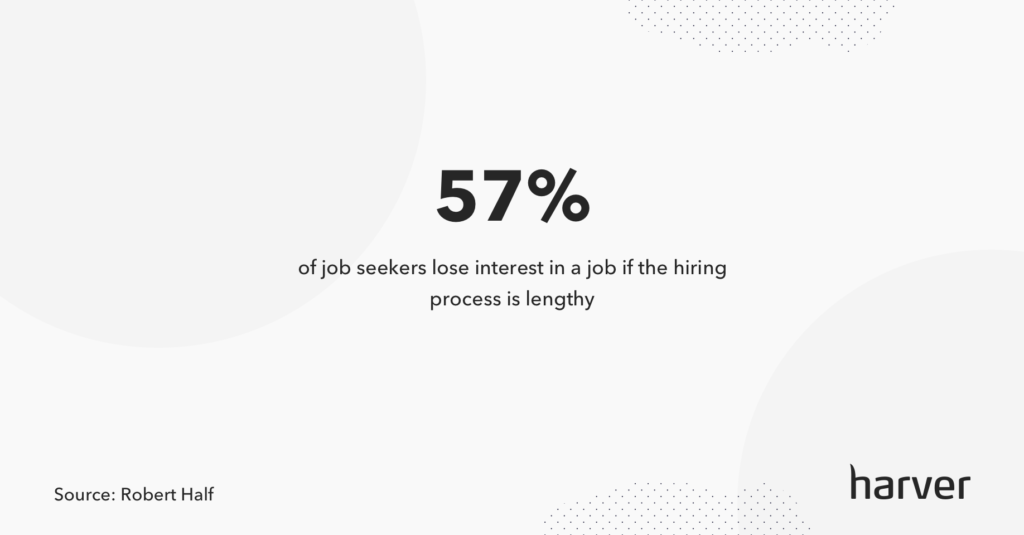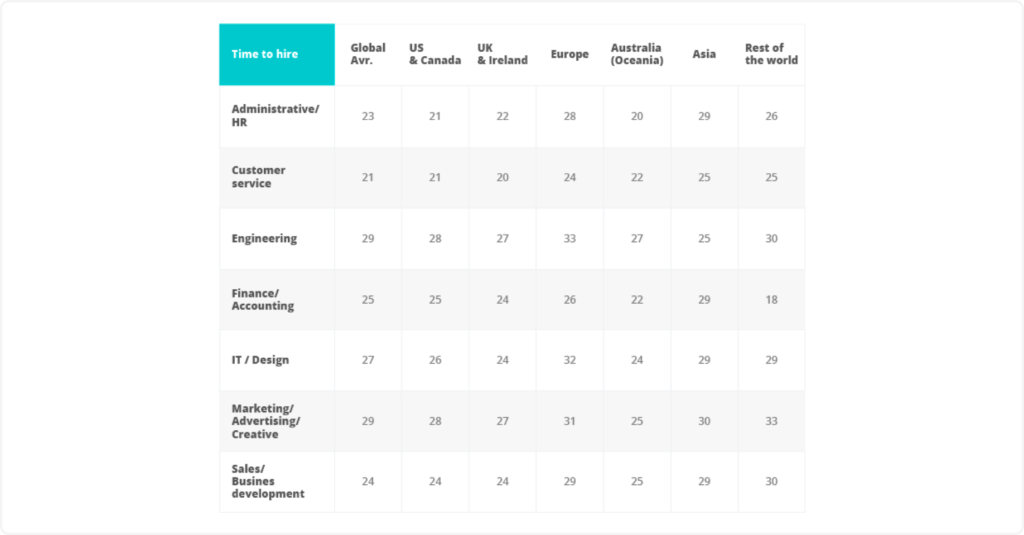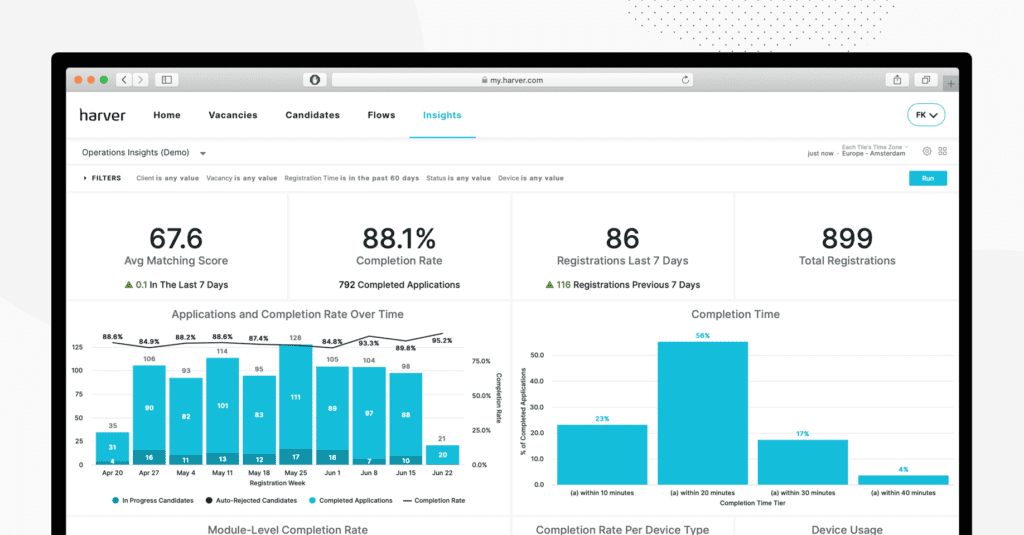Although there are numerous recruiting metrics, not many of them are measured as often as time to hire. In fact, no less than 50% of companies report using this metric.
Now, for clarity’s sake, a quick recap of what we mean when we say recruitment metrics: recruiting metrics are measurements used to track hiring success and optimize the process of hiring candidates for an organization.
Recruitment KPIs help to evaluate the recruiting process and to determine whether or not your company is hiring the right people.
In this article, we’ll zoom in on one particular metric: the time to hire (TTH).
What’s in?
What is time to hire?
Time to hire measures the number of days between the moment a candidate applies (or gets sourced) to the moment the candidate accepts the job.
Time to hire often gets mentioned in the same breath as time to fill. And while some say they are synonyms, we’ll treat them as two separate metrics in this article.
Time to fill measures the number of days it takes from the moment a job opening is posted to when the offer is accepted, while time to hire is measured from when the candidate enters the pipeline until the offer is accepted.
Where time to hire measures the efficiency of your recruitment process, time to fill is a great metric for business planning; it offers managers a realistic view of the time it will take to attract a replacement for an employee who left.

Time to fill vs. Time to hire
Time to fill measures the number of days it takes from the moment a job opening is posted to when the offer is accepted, while time to hire is measured from when the candidate enters the pipeline until the offer is accepted.
In other words:
- Time to fill tells you how fast your hiring process is.
- Time to hire tells you how quickly you were able to identify the best candidate.
As such, the latter is an indication of how effective your hiring team is.
Why should you measure time to hire?
Measuring time to hire can help you identify weak spots in your recruitment process and implement improvements. It can help you answer questions such as the ones below.
How long does it take you to find the right candidate?
This may seem an obvious one but it’s an aspect that shouldn’t be underestimated.
If your hiring team isn’t fast enough, they risk losing fast-moving (high quality) candidates. That is why it’s good to know exactly how long it takes to hire someone and for what kind of role.

How long does it take you to move candidates in the process once you’ve found the right person?
Your recruitment process can be broken down into several stages: CV screening, phone interview, assessment, in-person interview, etc. By breaking down your time to hire too, you can find out how long it takes for an average candidate to move from one stage to the next.
How much time do you need the next time you have to hire for the same role?
By tracking your time to hire for the different roles and/or departments in your organization, you will get a better understanding of how long it takes on average to hire a replacement.
How many resources do you need to hire for a certain role?
This question is linked to the previous one: when you know how much time you need to find and hire a candidate if two recruiters are working on it, then it’s probably safe to say that things will go quicker if an extra person is working on it with them.
Like what you see?
Don’t miss out. Subscribe to our quarterly digest to get the latest TA and TM resources delivered right to your inbox.
How to measure time to hire?
If we had to pour the time to hire metric into a formula, we’d use this one from Workable.
Time to hire = Day candidate accepted offer – Day candidate entered pipeline
– Workable
Let’s add an example to this formula to illustrate it.
Imagine your hiring team finds out there’s a new job opening on Monday. This is Day 1. They start working their magic and their best candidate accepts their job offer on Day 28 while he or she applied on day 13.
Your time to hire is 28 – 13 = 15.
You can measure time to hire for each role, but you can calculate your average time to hire as well.
If you hired for three roles recently and your time to hire for those was 15, 30 and 45 days respectively, then your average time to hire would be (15 + 30 + 45) / 3 = 30 days.
When it comes to measuring time to hire, there are several elements to take into account.
Measure time per stage
As we mentioned above, your hiring process can be broken down into different stages. Measuring the time candidates spend per stage gives you valuable information about the smooth and not-so-smooth parts of your hiring process.
Perhaps you’ll find out that it takes too long for candidates to move from the assessment to the in-person interview, for example, or from the final interview to the actual offer.
Having an overview of each part of the hiring process and the respective percentage of time they take up enables you to make improvements where necessary.

Distinguish between different roles and/or departments
Of course, not every role has the same time to hire. Some roles are simply easier to fill than others.
Depending on the requirements for the job, the number of available candidates on the market, and your hiring process, your time to hire will vary (a lot).
This is why it’s good to segment your time to hire by role and/or department. It will give you a more detailed overview of which jobs are tough to crack and, more importantly, why that is the case.
Is there, for example, an extra step in the hiring process or an additional level of approval that’s required before the offer can be sent out?
Track the quality of your applicants
If you know the ratio of good to poor applications you typically get this will help you diagnose if there is a slowdown happening in the sourcing phase.
Why this matters, you wonder? Because if this is the case, it will have an impact on your time to hire even if, officially speaking, the sourcing stage isn’t a part of the time to hire territory.
What happens if there aren’t many good applications is that recruiters keep those candidates in the pipeline until, at some point, a more suitable candidate comes along (at least that’s what they’re hoping for).
Unfortunately, this kind of ‘strategy’ is bad news for your candidate experience and your time to hire.
If you’re looking to improve your candidate selection process, our e-book below might help.
Stop guessing,
Start data-driven hiring.
Learn how you implement a modern candidate selection process, that is: streamlined, experience-driven and backed by data.

Industry data
When you’re measuring time to hire – and therefore gathering your own data – it can be useful to compare your results with those of your competitors.
Doing so will tell you something about where you stand. Are you (a lot) faster than the competition? In that case, you may want to check if you’re not being as thorough as you should be during the hiring process.
Are you (a lot) slower than your competitors? Then you may want to double-check your hiring process for inefficiencies and optimize certain parts of it.

Check out these industry benchmarks for time to hire from Workable and see how you stand. You can also check the research by Glassdoor to compare time to hire in countries and major cities around the world, as well as by jobs.
Best practices of measuring time to hire
Let’s take a look at a few recommendations of how to measure time to hire.
Be data-driven
As soon as we talk about measuring something it’s obvious that data is involved. So, of course, when it comes to measuring time to hire – and eventually reducing it where possible – data is key.
In that regard, here are a couple of types of data you should collect:
- How long it currently takes to fill various roles
- The time it takes for candidates to move from one stage to another
- How your time to hire compares with the industry average
- The calendar days from the final selection to making the job offer
- The ratio of good to poor applications you typically get
Once you’ve gathered all this data, choose the most alarming numbers and find ways to improve them.
For example, in the Harver platform, employers can easily see their recruitment metrics on a candidate level, or as aggregated data.

Stick to your measuring process
Make sure you record your time to hire the same way every time. Always start at the same point in the process, for example, and take your team’s vacation days into account if you did that when you had started measuring.
Couple time to hire with quality of hire
Although time to hire is without a doubt an important recruitment metric, it doesn’t provide a full insight into your hiring process on its own. That is why you should think about considering it in relation to another metric – quality of hire.
Quality of hire is a recruitment metric that measures the value new hires bring to an organization. As such, it’s used to evaluate how much a new hire contributes to the organization’s long-term success, based on their performance and tenure at the company.
Besides measuring how successful a new hire becomes, quality of hire can also be used to measure the success of the company’s recruiting efforts as a whole.
Combining time to hire with quality of hire enables you to get a better view of the strategies and processes that result in the best hires – and then replicate them.
Less isn’t always more
Decreasing your time to hire shouldn’t be a goal in itself. Yes, if there are parts of the hiring process that are inefficient and therefore take up too much time, it’s good to look at ways to improve this.
But skipping key parts of the process – such as reference checking or certain types of role-specific assignments – just to cut down your time to hire isn’t a good idea in the long term.
That’s why you should treat decreasing your time to hire more as an optimization of your process, as opposed to decreasing it at all costs.
Final thoughts
Measuring time to hire can be a great way to stay on top of your recruitment process. It’s a metric that can give you a lot of valuable insights into the great and not-so-great parts of your hiring system.
The best practices mentioned in this article should give you a good starting point. But as always, there is no one-size-fits-all solution. So, look at your organization and its unique recruiting process to determine what exactly you want to measure (first) and how you want to go about it.
Also, don’t forget that measuring your time to hire is just the first step in making use of this metric in your recruitment efforts. What follows is the application of various ways to reduce your time to hire and optimize your hiring process.
Take a look at these 10 ways to reduce your time to hire and find ones that you can implement in your recruitment process. Or check out how Albert Heijn, one of our retail clients, reduced their time to hire by implementing the Harver high volume recruitment solution.
If you’d like to see what our platform can do for your organization, book a demo below.
Ready to transform your hiring process?


